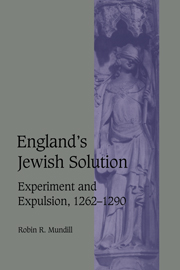Book contents
- Frontmatter
- Contents
- List of figures
- List of tables
- Preface
- Acknowledgements
- List of abbreviations
- Weights and measures
- Jewish nomenclature
- Chronology
- 1 The English Exodus re-examined
- 2 Jewish settlement, society and economic activity before the Statute of the Jewry of 1275
- 3 ‘The King's most exquisite villeins’: the views of royalty, Church and society
- 4 The royal tribute
- 5 The attempted prohibition of usury and the Edwardian Experiment
- 6 The economic fortunes of provincial Jewries under Edward I
- 7 The Christian debtors
- 8 Interpreting the English Expulsion
- Appendix I Places of jewish settlement, 1262-1290
- Appendix II The Statute of the Jewry, 1275
- Appendix III Articles touching the Jewry
- Appendix IV Charles of Anjou's Edict of Expulsion, 1289
- References
- Index
- Cambridge Studies in Medieval Life and Thought
3 - ‘The King's most exquisite villeins’: the views of royalty, Church and society
Published online by Cambridge University Press: 16 October 2009
- Frontmatter
- Contents
- List of figures
- List of tables
- Preface
- Acknowledgements
- List of abbreviations
- Weights and measures
- Jewish nomenclature
- Chronology
- 1 The English Exodus re-examined
- 2 Jewish settlement, society and economic activity before the Statute of the Jewry of 1275
- 3 ‘The King's most exquisite villeins’: the views of royalty, Church and society
- 4 The royal tribute
- 5 The attempted prohibition of usury and the Edwardian Experiment
- 6 The economic fortunes of provincial Jewries under Edward I
- 7 The Christian debtors
- 8 Interpreting the English Expulsion
- Appendix I Places of jewish settlement, 1262-1290
- Appendix II The Statute of the Jewry, 1275
- Appendix III Articles touching the Jewry
- Appendix IV Charles of Anjou's Edict of Expulsion, 1289
- References
- Index
- Cambridge Studies in Medieval Life and Thought
Summary
Having seen how the Jewish communities became established in England during the twelfth and thirteenth centuries it is now important to see how they were perceived by their royal protectors and the Church, as well as by the population at large. It was the Jews’ business dealings such as the mortgaging of land and the lending of money that brought them into contact with officials, nobles, clergy and townspeople as well as those living in the countryside. From time to time, their business resulted in a ‘partnership’ with abbeys and Church institutions as well as with individuals who benefited from the traffic in Jewish debts. Early in the thirteenth century, lay and clerical entrepreneurs who gained land by paying off Jewish debts clearly did not have troubled consciences about dealing with Jews. On the other hand the debtors who lost their land were certainly troubled. Their indebtedness and loss caused resentment and fuelled hatred for the Jew and possibly even for their new landlord. However there must also have been a group of debtors of whom little is known, who managed to repay their debts and who might well have actually gained from transacting business with Jewish financiers. Thus, there were many Christians who were directly or indirectly involved with Jewish finance and who naturally had varying attitudes towards the Jews. Yet, as debtors started to fail on their repayments and as the lawlessness which accompanied the midcentury rebellion spread, so the protection of those who had tolerated
Richardson 1960, pp. 13-22; Nottingham RO M24/182-8, the Lassman Papers.
- Type
- Chapter
- Information
- England's Jewish SolutionExperiment and Expulsion, 1262–1290, pp. 45 - 71Publisher: Cambridge University PressPrint publication year: 1998



